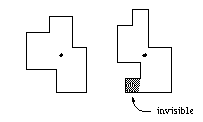POJ 1474 Video Surveillance 半平面交求多边形是否有核
来源:互联网 发布:韩国衣服品牌 淘宝 编辑:程序博客网 时间:2024/04/27 13:48
裸的半平面交求多边形是否有核.
多边形的核: 在多边形核上的点可以看到多边形的所有顶点,凸多边形的核显然就是多边形本身.
多边形的核是一个凸包,对多边形的所有边都做向着多边形的半平面交在判断一下是否构成凸包就可以了
一样的题目还有POJ3335
Video Surveillance
Time Limit: 1000MS Memory Limit: 10000KTotal Submissions: 3438 Accepted: 1523
Description
A friend of yours has taken the job of security officer at the Star-Buy Company, a famous depart- ment store. One of his tasks is to install a video surveillance system to guarantee the security of the customers (and the security of the merchandise of course) on all of the store's countless floors. As the company has only a limited budget, there will be only one camera on every floor. But these cameras may turn around to look in every direction.
The first problem is to choose where to install the camera for every floor. The only requirement is that every part of the room must be visible from there. In the following figure the left floor can be completely surveyed from the position indicated by a dot, while for the right floor, there is no such position, the given position failing to see the lower left part of the floor.

Before trying to install the cameras, your friend first wants to know whether there is indeed a suitable position for them. He therefore asks you to write a program that, given a ground plan, de- termines whether there is a position from which the whole floor is visible. All floor ground plans form rectangular polygons, whose edges do not intersect each other and touch each other only at the corners.
The first problem is to choose where to install the camera for every floor. The only requirement is that every part of the room must be visible from there. In the following figure the left floor can be completely surveyed from the position indicated by a dot, while for the right floor, there is no such position, the given position failing to see the lower left part of the floor.

Before trying to install the cameras, your friend first wants to know whether there is indeed a suitable position for them. He therefore asks you to write a program that, given a ground plan, de- termines whether there is a position from which the whole floor is visible. All floor ground plans form rectangular polygons, whose edges do not intersect each other and touch each other only at the corners.
Input
The input contains several floor descriptions. Every description starts with the number n of vertices that bound the floor (4 <= n <= 100). The next n lines contain two integers each, the x and y coordinates for the n vertices, given in clockwise order. All vertices will be distinct and at corners of the polygon. Thus the edges alternate between horizontal and vertical.
A zero value for n indicates the end of the input.
A zero value for n indicates the end of the input.
Output
For every test case first output a line with the number of the floor, as shown in the sample output. Then print a line stating "Surveillance is possible." if there exists a position from which the entire floor can be observed, or print "Surveillance is impossible." if there is no such position.
Print a blank line after each test case.
Print a blank line after each test case.
Sample Input
40 00 11 11 080 00 21 21 12 12 23 23 00
Sample Output
Floor #1Surveillance is possible.Floor #2Surveillance is impossible.
Source
Southwestern European Regional Contest 1997
/* ***********************************************Author :CKbossCreated Time :2015年04月09日 星期四 19时43分00秒File Name :POJ1474.cpp************************************************ */#include <iostream>#include <cstdio>#include <cstring>#include <algorithm>#include <string>#include <cmath>#include <cstdlib>#include <vector>#include <queue>#include <set>#include <map>using namespace std;#define mp make_pair#define pb push_backconst double eps = 1e-8;const double pi = acos(-1.0);const double inf = 1e20;const int maxp = 111;int dcmp(double d) { if(fabs(d)<eps) return 0; return (d<0)?-1:1; }inline double sqr(double x) { return x*x; }struct point{double x,y;point(double _x=0,double _y=0):x(_x),y(_y){}void input() { scanf("%lf%lf",&x,&y); }void output() { printf("%.2lf %.2lf\n",x,y); }bool operator==(point a) const { return dcmp(a.x-x)==0&&dcmp(a.y-y)==0; }bool operator<(point a) const { return dcmp(a.x-x)==0?dcmp(y-a.y)<0:x<a.x; }double len() { return hypot(x,y); }double len2() { return x*x+y*y; }double distance(point p) { return hypot(x-p.x,y-p.y); }point add(point p) { return point(x+p.x,y+p.y); }point sub(point p) { return point(x-p.x,y-p.y); }point mul(double b) { return point(x*b,y*b); }point div(double b) { return point(x/b,y/b); }double dot(point p) { return x*p.x+y*p.y; }double det(point p) { return x*p.y-y*p.x; }double rad(point a,point b){point p=*this;return fabs(atan2(fabs(a.sub(p).det(b.sub(p))),a.sub(p).dot(b.sub(p))));}};struct line{point a,b;line(){}line(point _a,point _b) { a=_a; b=_b; }bool operator==(const line v) const { return (a==v.a)&&(b==v.b); }bool parallel(line v) { return dcmp(b.sub(a).det(v.b.sub(v.a)))==0; }point crosspoint(line v){double a1=v.b.sub(v.a).det(a.sub(v.a));double a2=v.b.sub(v.a).det(b.sub(v.a));return point((a.x*a2-b.x*a1)/(a2-a1),(a.y*a2-b.y*a1)/(a2-a1));}};struct halfplane:public line{double angle;halfplane(){}/// a-->b lefthalfplane(point _a,point _b){ a=_a; b=_b;}halfplane(line v) { a=v.a; b=v.b; }void calcangle() { angle=atan2(b.y-a.y,b.x-a.x); }bool operator<(const halfplane &b) const { return angle<b.angle; }};struct halfplanes{int n;halfplane hp[maxp];point p[maxp];int que[maxp];int st,ed;void push(halfplane tmp){hp[n++]=tmp;}void unique(){int m=1,i;for(i=1;i<n;i++){if(dcmp(hp[i].angle-hp[i-1].angle)) hp[m++]=hp[i];else if(dcmp(hp[m-1].b.sub(hp[m-1].a).det(hp[i].a.sub(hp[m-1].a))>0))hp[m-1]=hp[i];}n=m;}bool halfplaneinsert(){int i;for(int i=0;i<n;i++) hp[i].calcangle();sort(hp,hp+n);unique();que[st=0]=0; que[ed=1]=1;p[1]=hp[0].crosspoint(hp[1]);for(i=2;i<n;i++){while(st<ed&&dcmp((hp[i].b.sub(hp[i].a).det(p[ed].sub(hp[i].a))))<0) ed--;while(st<ed&&dcmp((hp[i].b.sub(hp[i].a).det(p[st+1].sub(hp[i].a))))<0) st++;que[++ed]=i;if(hp[i].parallel(hp[que[ed-1]])) return false;p[ed]=hp[i].crosspoint(hp[que[ed-1]]);}while(st<ed&&dcmp((hp[st].b.sub(hp[que[st]].a).det(p[ed].sub(hp[que[st]].a))))<0) ed--;while(st<ed&&dcmp((hp[que[ed]].b.sub(hp[que[ed]].a).det(p[st+1].sub(hp[que[ed]].a))))<0) st++;if(st+1>=ed) return false;return true;}};int n;int main(){ //freopen("in.txt","r",stdin); //freopen("out.txt","w",stdout);int cas=1;while(scanf("%d",&n)&&n){vector<point> vp;for(int i=0;i<n;i++){point tp; tp.input(); vp.pb(tp);}halfplanes hfs; hfs.n=0;for(int i=0;i<n;i++){//// p[i] <--- p[i+1]hfs.push(halfplane(vp[(i+1)%n],vp[i]));}printf("Floor #%d\n",cas++);bool isok=hfs.halfplaneinsert();if(isok==true) puts("Surveillance is possible.");else puts("Surveillance is impossible.");putchar(10);} return 0;} 1 0
- POJ 1474 Video Surveillance 半平面交求多边形是否有核
- [poj 1474]Video Surveillance[半平面交][多边形的核]
- POJ 1474 Video Surveillance 半平面交求多边形内核存在性
- POJ 1474 Video Surveillance(半平面交)
- POJ 1474 || Video Surveillance(半平面交
- poj 1474 Video Surveillance 半平面交
- POJ 1474 Video Surveillance(判断多边形是否有核)
- poj 1474 Video Surveillance - 求多边形有没有核
- boj 35 Video Surveillance 半平面交求多边形的核
- poj 1474 Video Surveillance(半平面交)
- POJ 1474 Video Surveillance (半平面交判断)
- poj 1474 Video Surveillance (半平面交)
- poj 1474 Video Surveillance(半平面交)
- poj 1474 半平面交求多边形的核
- POJ 1474 ZOJ 1248 HDU 1469 Video Surveillance 半平面交
- [POJ1474]Video Surveillance(半平面交)
- poj1474 Video Surveillance【半平面交】
- poj 3335 Rotating Scoreboard(判断多边形是否有核+半平面交)
- 107Binary Tree Level Order Traversal II
- 常见的IO模型
- hdu 1176 免费馅饼(nyist 613)
- SCU oj 4424 Permutations(递推)
- Android中Intent传递对象的两种方法:Serializable & Parcelable
- POJ 1474 Video Surveillance 半平面交求多边形是否有核
- Maven最佳实践:版本管理
- 链表的创建、逆序显示、插入显示
- 编程之美2:寻找最大的K个数
- P51第17题
- 0-1分数规划(nyoj914 Yougth的最大化)
- 【每日一发】基于JS的图片瀑布流
- c++Primer,第十六章,模板和泛型编程
- find命令的几个例子解析(-a,-o,-path,-wholename,-prnue,-print)


